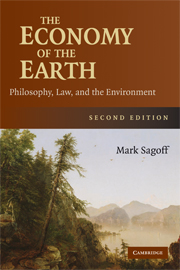Book contents
- Frontmatter
- Contents
- Acknowledgments
- 1 Introduction
- 2 At the Shrine of Our Lady of Fatima or Why Political Questions Are Not All Economic
- 3 The Allocation and Distribution of Resources
- 4 Values and Preferences
- 5 Can We Put a Price on Nature's Services?
- 6 Do We Consume Too Much?
- 7 Is an Environmental Ethic Compatible with Biological Science?
- 8 Settling America or the Concept of Place in Environmental Ethics
- 9 Natural and National History
- 10 Environmentalism: Death and Resurrection
- Notes
- Index
- Frontmatter
- Contents
- Acknowledgments
- 1 Introduction
- 2 At the Shrine of Our Lady of Fatima or Why Political Questions Are Not All Economic
- 3 The Allocation and Distribution of Resources
- 4 Values and Preferences
- 5 Can We Put a Price on Nature's Services?
- 6 Do We Consume Too Much?
- 7 Is an Environmental Ethic Compatible with Biological Science?
- 8 Settling America or the Concept of Place in Environmental Ethics
- 9 Natural and National History
- 10 Environmentalism: Death and Resurrection
- Notes
- Index
Summary
A New Yorker cartoon depicts a pair of Puritans in stiff collars, doublets, and cloaks leaning over the rail of the Arbella as it made landfall in the New World. One says, “My immediate goal is to worship God and celebrate His Creation, but long-term, I plan to get into real estate.”
The cartoon presents two visions of the natural world. On the one hand, we may regard nature as sacred, as having a value in itself, a history, autonomy, and diversity that command our appreciation and respect. On the other hand, we can regard the natural world as a storehouse of economically fungible resources to be developed for human benefit. With these two visions of nature come two conceptions of salvation. The first is personal; if one learns to commune with Nature and to study its meanings and messages, one may become more secure and decent in one's soul. The second is collective. If humanity develops natural resources efficiently over the long term, it can maximize wealth and well-being. With the advance of science and technology, humanity may escape from scarcity, and where there is no want (as the philosopher David Hume argued) there is no injustice. An efficient economy can bring Heaven to Earth.
- Type
- Chapter
- Information
- The Economy of the EarthPhilosophy, Law, and the Environment, pp. 1 - 23Publisher: Cambridge University PressPrint publication year: 2007

